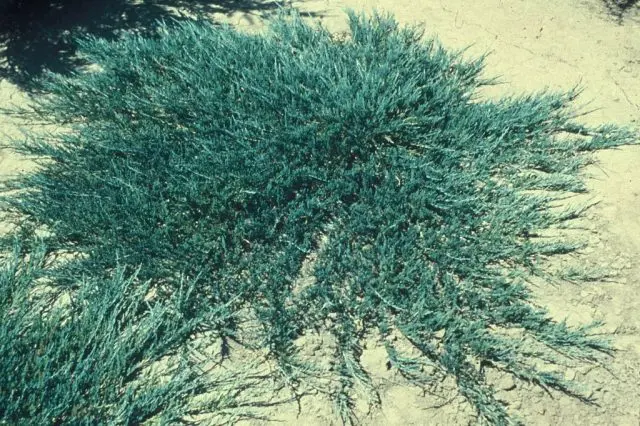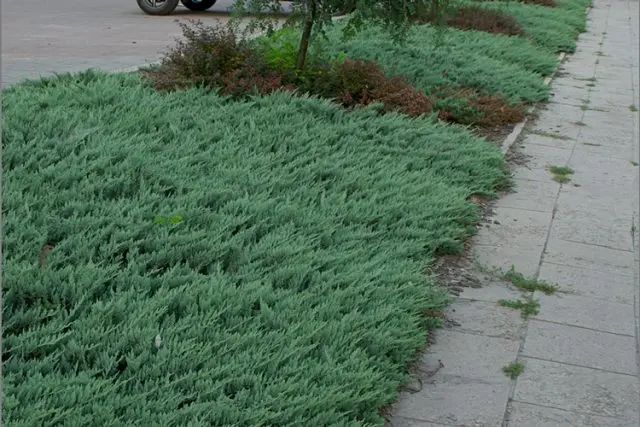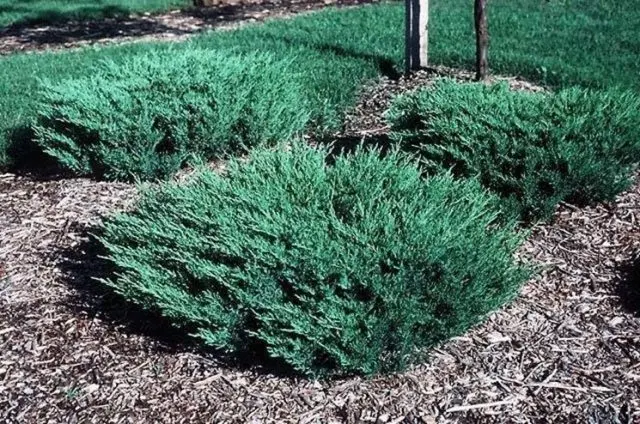Contents
- Description of juniper horizontal
- Juniper horizontal in landscape design
- Varieties of horizontal juniper
- Planting and caring for juniper horizontal
- Juniper blossoms horizontal
- Propagation of juniper prostrate
- Diseases and pests
- Juniper horizontalis poisonous or not
- Conclusion
- Reviews of the horizontal juniper
Juniper horizontal – one of the very popular options for decorating a garden or summer cottage. In order for a coniferous shrub to please the eye for many years, you need to understand its varieties and the basic rules of care.

Description of juniper horizontal
The horizontal juniper, which is also called prostrate or flat, belongs to the Cypress family and the Juniper species. The most characteristic feature of a coniferous shrub, which distinguishes it from other species, is short stature – the plant can reach no more than 50 cm in height, and, moreover, the development of the shrub is very slow.
The average width of the horizontal juniper varies from 1 to 2,5 m, the plant lives for about 200 years. Coniferous needles on the branches of a shrub can be short scaly, up to 2,5 mm, or long needle-shaped, up to 5 mm. The photo of a horizontal juniper shows that it can have a bright green, yellowish, silvery or bluish color, the color depends on the variety of the shrub and on the illumination of the site.
In the wild, the horizontal shrub grows mainly in North America and Canada on mountain slopes and on sandy river banks. Ornamental prostrate juniper is grown all over the world, it is undemanding to the soil, it tolerates drought and frost well.
Juniper horizontal in landscape design
Horizontal coniferous shrub is valued primarily for its decorative qualities. In landscape design, it is used all over the world – the shrub fits well into Japanese, English and French landscape styles, favorably complements the classic and modern design of the site.
Since the horizontal juniper is not tall, it is most often used:
- for the design of borders;
- to create a green carpet on rocky areas of the garden;
- to strengthen the banks of artificial reservoirs;
- for the design of alpine slides;
- to divide the space into functional zones;
- to smooth out uneven ground.
The shrub goes well with other plants – with most varieties of conifers, with heather, with barberry. You can plant a horizontal shrub near the flower beds – a solid dense juniper will emphasize the brightness and richness of the flower arrangement.
Varieties of horizontal juniper
Species and varieties with a photo of horizontal juniper are in the dozens. Many garden forms of this shrub have been artificially bred, among them you can find beautiful and unpretentious plants for any garden.
Juniper horizontal BlueForest
Blue Forest horizontal juniper can reach no more than 40 cm in height and 1,5 m in width. It has a dense creeping crown, the branches of the shrub are flexible and short, the side shoots are directed vertically upwards. According to the description, the Blue Forest juniper is a scaly type with thick short needles, the needles of the plant have a silvery bluish tint, and in winter the shrub becomes purple.

Blue juniper is fairly easy to care for, prefers loose soil with good aeration, and grows best in full sun. The variety tolerates frosts well, another of its advantages is resistance to poor ecology. Thanks to this, a horizontal shrub is planted not only in summer cottages, but also in urban gardens and front gardens.
Juniper horizontalis Glauka
Juniper Glauka can grow quite high for a horizontal shrub – up to 1 m. The width of the crown is usually 2-3 m, a juniper can add up to 5 cm in height per year. It has a spreading scaly crown, in summer the needles of a horizontal shrub are blue-blue, and in winter the needles acquire a bronze hue.
Juniper horizontalis Glauca tolerates drought and cold snap well, but requires a lot of sunlight – shading affects the health of the shrub negatively.
Juniperus horizontalus Jade River
The juniper variety Jade River is characterized by a very small height – only about 15-20 cm above the ground. The width of the shrub can spread up to 1,5 m, the needles have a bluish-green tint, the young shoots of juniper are silvery.
Jade River tolerates poor soils and light shade. But when growing a horizontal shrub, attention must be paid to watering – during periods of summer drought, additional moisture is required.
Juniper horizontalis Glacier
A miniature variety of ground cover juniper does not exceed 20 cm in height and 1,5 m in width. The needles of the shrub are scaly, the shoots are roller-shaped, the needles have a gray-blue tint in summer and brown in winter.
The variety demonstrates good frost resistance and successfully takes root on poor soils. Juniper horizontal Glacier can be planted both in bright sun and in light shade, but it is necessary to monitor the level of soil moisture. The plant does not tolerate stagnant water, although excessively dry air is also harmful to it.
Juniper horizontalis Alpina
The Alpina variety grows up to an average of 50 cm, and the width of the crown can be about 2 m. A characteristic feature of the variety is that Alpina, compared to other varieties, is a fast-growing horizontal juniper. In addition, Alpina shoots young shoots vertically upwards – only then do they lean towards the ground, due to which the shrub acquires a wavy relief.
The needles of the Alpina variety are gray-green, scaly type, turning brown in winter. The shrub prefers light soils and sunny places, tolerates frosty winters well.
Juniper horizontal Winter Blue
The decorative variety Winter Blue grows on average up to 60 cm in height and reaches 1,5 m in length, has dense creeping shoots that form a pillow-shaped crown. The needles of the shrub are needle-shaped, with a greenish-blue or bluish tinge. An atypical feature of the Winter Blue variety is that in winter the shrub does not change color.

The variety withstands frosts and light shading well, but the soil for it needs to be selected light and well aerated – Winter Blue does not tolerate dense soil. The horizontal shrub loves moisture, but reacts negatively to stagnant water and waterlogging.
Juniper horizontalis Gray Pearl
The Gray Pearl variety is a slow growing horizontal shrub capable of reaching a maximum of 40 cm in height and 1,5 m in width. The shoots of a dwarf shrub are directed upwards and are densely covered with needle-shaped blue-green needles with a steel tint.
Horizontal juniper Gray Pearl perfectly tolerates frost and wintering under snow, does not impose increased requirements on soil fertility. But the soil for the shrub needs light, saturated with air, and the site for the variety must be chosen well-lit – in the shade, the juniper quickly withers.
Juniper horizontalus Yukon Bel
The Yukon Bel variety is a dwarf ground cover shrub, reaching an average of 10-20 cm in height and about 1,5 m in width. The shoots of the juniper horizontal Yukon Belle are thick, creeping, and the needles are scaly silver-gray.
The horizontal shrub of this variety spends the winter under the snow and tolerates even severe frosts well. Yukon Bel is undemanding to the amount of moisture, therefore, when planting, it is only important to choose a sunny area and take care of good aeration of the soil – heavy soils are contraindicated for shrubs.
Planting and caring for juniper horizontal
Since the plant is unpretentious, caring for a horizontal juniper is not particularly difficult. A coniferous shrub suitable for growing in the middle lane, requires minimal care. However, the basic rules for growing creeping juniper need to be known.
Seedling and planting preparation
Best of all, juniper seedlings that have reached 2-3 years old take root in open ground. Before buying planting material, you need to carefully examine its trunk and shoots, the seedling must be absolutely healthy, a diseased plant may not tolerate planting or create too much trouble when growing. A few hours before planting in the ground, a young horizontal shrub, together with a clod of earth, is recommended to be soaked in water, if desired, a solution can be added to it to stimulate plant growth.
An important stage is the choice of a place for planting a coniferous shrub. Most varieties of horizontal juniper prefer well-lit areas, although some shade is also acceptable. Juniper does not tolerate strong winds, so it is better to plant it under the natural cover of tall plants or near buildings and walls.
Coniferous horizontal shrub takes root well on poor soils, but can die in heavy and dense soil. The soil for juniper should be light, loamy or sandy, in order to avoid stagnant water, it is recommended to organize high-quality drainage. If the soil on the site is unsuitable for horizontal juniper, you need to create a soil mixture with your own hands – mix humus and soddy soil, add peat and add sand in proportions of 2: 2: 2: 1.

How to plant juniper horizontal
When transferring a horizontal juniper seedling to the ground, first of all, it is necessary to determine the timing of planting. Planting a horizontal juniper in the spring is carried out most often, especially if the root system of the shrub is open. The optimal period is April-May.
The landing pattern looks like this:
- a spacious hole is dug in advance on the site, approximately 2,5 times larger than the diameter of the seedling, taking into account the earthen coma;
- drainage is laid at the bottom of the hole, and a layer of prepared soil is poured on top to about half;
- together with a clod of earth at the roots, the juniper is lowered into the pit and the hole is covered with soil to the top.
The soil needs to be slightly crushed, but it is not necessary to trample it down – the soil should sink on its own. If we are talking about planting several horizontal shrubs, you need to take into account the maximum crown diameter of each of them and leave gaps of at least 1,5 m between individual seedlings.
Immediately after planting, the juniper is watered, and the ground is sprinkled with foliage or sawdust with a layer of several centimeters.
Watering and top dressing
Most varieties of coniferous shrubs tolerate drought well, but do not tolerate waterlogging. Accordingly, it is necessary to water a horizontal shrub only in the hottest summer periods, and if groundwater passes close to the surface of the earth, limit the amount of water to the maximum.
In addition to watering, it is recommended to sprinkle the crown, spray the shoots with soft water at room temperature. Sprinkling should be carried out in the morning, in the evening or on cloudy days – under the bright sun, spraying can lead to burns of the needles.
Since the shrub does not impose high requirements on the composition of the soil, it almost does not need top dressing. In the spring, it is recommended to add nitrogenous fertilizers to the soil for better growth – about 30-40 g per square meter. But it is absolutely impossible to use bird or cow humus – for coniferous plants, such top dressing is detrimental and leads to chemical burns of the roots.
Mulching and loosening
Mulching for a horizontal shrub is recommended immediately after planting – the moist soil around the seedling is covered with a dense layer of coniferous bark, peat or wood chips. Mulch not only prevents evaporation of moisture, but also protects the near-trunk circle from weeds, and in winter protects juniper roots from freezing.
However, at least once a year, it is recommended to remove the mulch, and loosen the soil – to saturate the earth with oxygen and to avoid rotting of the root collar. In this case, loosening must be carried out very carefully – the roots of the horizontal juniper lie close to the surface, and they are easy to damage.

Juniper pruning horizontal
For coniferous shrubs, pruning is divided into 2 varieties – sanitary and decorative. The first is recommended to be carried out annually, removing all dried, weakened and diseased branches.
Decorative pruning is carried out as needed, in the volumes that are required to form a beautiful crown. In the process of pruning branches, it is important to use a sterile and very sharp tool. In addition, you can not cut more than 7 cm of healthy shoots, otherwise the horizontal shrub will be too seriously damaged, and most likely it will die.
Preparation for winter
Preparation of a horizontal juniper for winter consists mainly in the construction of a shelter. Although the plant tolerates low temperatures well, severe frosts can still damage the shrub, and besides, the horizontal shrub is sensitive to heavy snow cover, strong winds and bright winter sun.
As a shelter for a horizontal shrub, the following materials are mainly used:
- snow – it perfectly covers the shrub from wind, frost and sun, however, it is recommended to throw snow on the protective frame, otherwise the branches of the plant may break;
- burlap, kraft paper and cotton light fabric – the material is fixed in the upper part of the crown, it is not recommended to use the film, since high humidity forms under it;
- screens – they are installed from the illuminated side to protect the juniper from the winter sun, the metallized substrate used for laying the laminate is best suited for shielding, but it is better to refuse cardboard sheets and lutrasil.
Juniper blossoms horizontal
In June, the horizontal shrub blooms profusely, but its flowering has its own characteristics. The coniferous shrub does not produce ordinary flowers, but round-shaped female light green cones and male elongated catkins with several stamens. Flowering occurs in June, and from August to September, the ornamental shrub bears fruit – small berries of a dark purple color.
Propagation of juniper prostrate
Wild-growing juniper can also be propagated by seeds, but cuttings are used for decorative horizontal shrubs. It is carried out in the spring, and the process looks like this:
- in an adult plant, a shoot is cut about 12 cm long;
- all the needles are removed from the handle and immersed in a solution with a growth stimulator for a day;
- after that, the cutting is planted in a small pot in the prepared soil – a mixture of sand and peat in a ratio of 1 to 1.
The cuttings are deepened by about 3 cm, immediately after planting they are watered and covered with a film for 1,5 months. Throughout this time, every 5-6 hours, the film must be removed so that the cuttings can breathe. The substrate is moistened if necessary, the temperature is maintained at least 22 degrees.
Reproduction of horizontal juniper by cuttings will bring results in 2 months, the cutting will give roots, and it can be transplanted into a larger pot. Landing in open ground is carried out only after 2-3 years, when the seedling is well established.

Diseases and pests
The horizontal shrub is a fairly disease-resistant plant. However, it is affected by some common diseases of coniferous shrubs, namely:
- shute – a fungal disease that develops mainly with a lack of light;
- fuzarioz – a disease that provokes excessive moisture;
- rust – the disease appears due to the poor composition of the soil.
In addition, insects can harm the shrub – spider mites, scale insects and aphids. It is recommended to fight diseases and pests primarily with the help of prevention. Once a year, the shrub must be treated with fungicides and insecticidal agents; sanitary pruning and cleaning of fallen material in the immediate vicinity of the bushes are mandatory.
If the shrub has already suffered from pests and diseases, the first step is to remove all damaged parts. After that, the plant must be treated with Bordeaux liquid and fungicides – and in the future, carefully adhere to the growing conditions.
Juniper horizontalis poisonous or not
Suitable for consumption for culinary and medicinal purposes are only the fruits of the common juniper. As for the horizontal juniper Juniperus Horizontalis, such a shrub is very toxic – its berries can lead to serious poisoning. It is recommended to breed ornamental shrubs only for aesthetic purposes.
Conclusion
Juniper horizontalis is a beautiful ornamental plant, represented by many varieties. A coniferous shrub can decorate almost any landscape, and it is easy enough to care for even for beginners.









